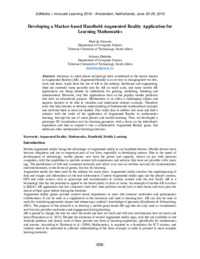Developing a Marker-based Handheld Augmented Reality Application for Learning MathematicsMawuli Akussah, Johnson Dehinbo
Zu finden in: EdMedia 2018, 2018
|
 |
 Diese Seite wurde seit 6 Jahren inhaltlich nicht mehr aktualisiert.
Unter Umständen ist sie nicht mehr aktuell.
Diese Seite wurde seit 6 Jahren inhaltlich nicht mehr aktualisiert.
Unter Umständen ist sie nicht mehr aktuell.
 Zusammenfassungen
Zusammenfassungen
Advances in smart phone technology have contributed to the recent interest in Augmented Reality (AR). Augmented Reality is on its way to changing how we live, work and learn. Apart from the use of AR in the military, healthcare and engineering, there are currently many possible uses for AR on small scale, and many mobile AR applications are being created by individuals for gaming, marketing, branding and entertainment. However, very few applications exist on the popular mobile platforms that have an educational purpose. Mathematics is an often a challenging subject and requires learners to be able to visualize and understand abstract concepts. Therefore tools that help learners to develop understanding of fundamental mathematical concepts and motivate them to learn are needed. This study aims to address this issue and find a solution with the study of the application of Augmented Reality in mathematics learning, through the use of smart phones and mobile learning. Thus, we developed a prototype 3D visualization tool for learning geometry, with a focus on the individual's experience and then to expand it into a collaborative Augmented Reality game, that addresses other mathematical learning outcomes.
Von Mawuli Akussah, Johnson Dehinbo im Konferenz-Band EdMedia 2018 (2018) im Text Developing a Marker-based Handheld Augmented Reality Application for Learning Mathematics  Volltext dieses Dokuments
Volltext dieses Dokuments
 |  Developing a Marker-based Handheld Augmented Reality Application for Learning Mathematics: Volltext als PDF ( Developing a Marker-based Handheld Augmented Reality Application for Learning Mathematics: Volltext als PDF ( : :  , 533 kByte; , 533 kByte;  : :  2021-03-21) 2021-03-21) |
 Anderswo suchen
Anderswo suchen 
 Beat und dieses Konferenz-Paper
Beat und dieses Konferenz-Paper
Beat hat Dieses Konferenz-Paper während seiner Zeit am Institut für Medien und Schule (IMS) ins Biblionetz aufgenommen. Er hat Dieses Konferenz-Paper einmalig erfasst und bisher nicht mehr bearbeitet. Beat besitzt kein physisches, aber ein digitales Exemplar. Eine digitale Version ist auf dem Internet verfügbar (s.o.). Aufgrund der wenigen Einträge im Biblionetz scheint er es nicht wirklich gelesen zu haben. Es gibt bisher auch nur wenige Objekte im Biblionetz, die dieses Werk zitieren.











 Biblionetz-History
Biblionetz-History